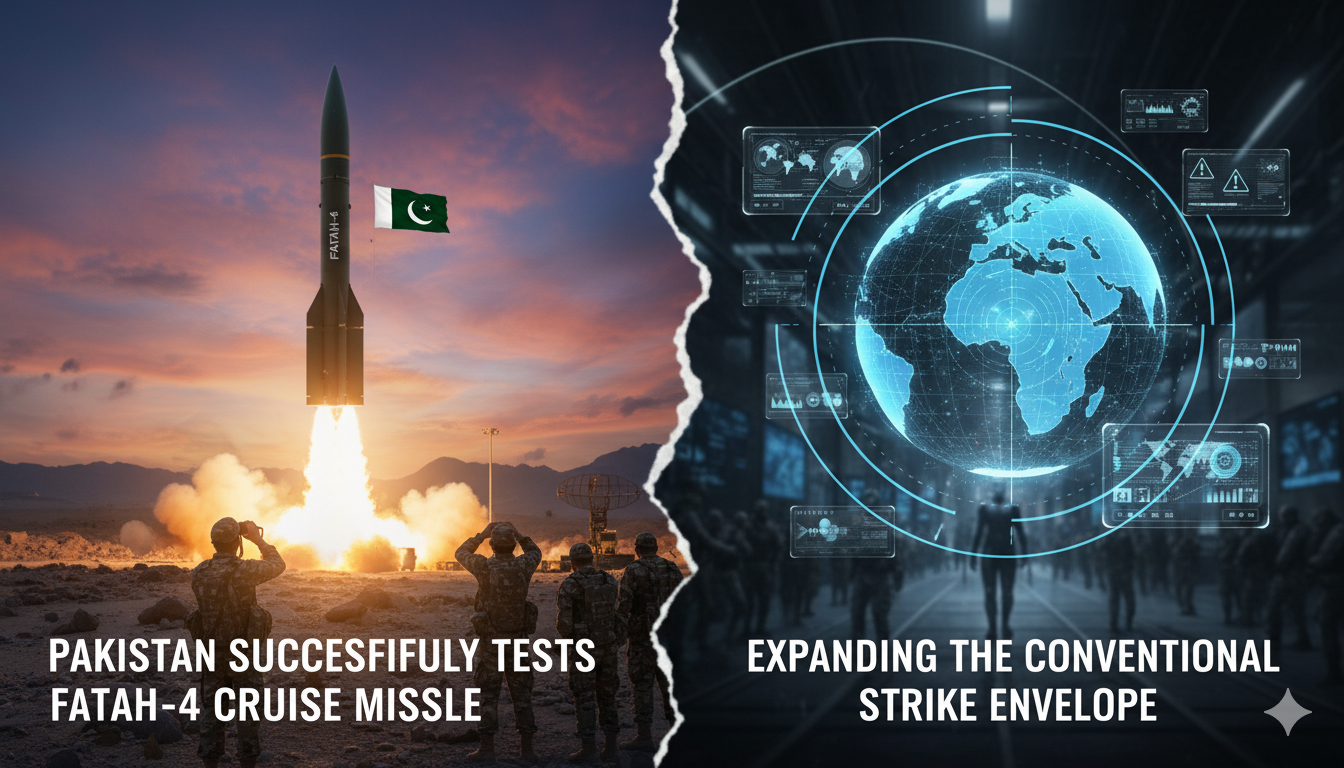Pakistan has announced the successful test-firing of the Fatah-4 (also spelled Fateh-4) cruise missile, a development that signals continued advances in its indigenous missile program. Conducted under the newly formed Army Rocket Force Command, the launch was presented by the military as a training exercise, but the significance of the test goes far beyond routine drills. With a declared range of around 750 km, the Fatah-4 is being positioned as a new cornerstone in Pakistan’s conventional deterrence capability.
Technical Characteristics of the Fatah-4
While official technical specifications remain closely guarded, multiple defence outlets and reports highlight the following key features of the missile:
- Type: Ground-launched land-attack cruise missile (LACM).
- Range: Approximately 750 km, enabling strikes deep into adversary territory.
- Warhead: ~330 kg high-explosive / blast-fragmentation payload.
- Accuracy: Claimed ~5 m Circular Error Probable (CEP), suggesting near-precision targeting.
- Speed: Subsonic, around Mach 0.7, typical for terrain-hugging cruise missiles.
- Survivability: Designed for low-altitude flight profiles, hugging terrain to avoid radar detection and evade modern air-defence systems.
- Guidance: Reportedly integrates modern navigation systems, with some accounts pointing to AI-assisted guidance for enhanced accuracy.
- Dimensions: Approximate length of 7.5 m and weight around 1,530 kg (reported by technical trackers).
The Fatah-4 follows the Fatah-1 and Fatah-2 rocket artillery systems and the earlier Babur cruise missile family, underscoring Pakistan’s move toward a layered and diversified missile arsenal.
Strategic Significance
The test of the Fatah-4 is less about introducing an entirely new class of missile and more about solidifying Pakistan’s conventional strike doctrine. With its ability to engage targets at extended ranges, the missile gives Islamabad a credible conventional tool to respond to aggression without immediate recourse to nuclear options.
From a doctrinal standpoint, this expands Pakistan’s capacity for:
- Deep-strike conventional deterrence — capable of reaching critical military infrastructure well beyond the border.
- Psychological signaling — demonstrating indigenous capability at a time of heightened regional competition.
- Operational flexibility — supplementing longer-range ballistic missiles with precision land-attack cruise missiles that are harder to detect and intercept.
For India, this complicates the calculus of air defence, especially when integrated with Pakistan’s broader missile strategy.
Indian Response
Indian media outlets have covered the Fatah-4 test with notable attention, though no official response has yet been issued by New Delhi’s Ministry of Defence or Ministry of External Affairs. The tone has remained analytical and measured, focusing primarily on the missile’s declared capabilities.
- The Economic Times reported: “Pakistan successfully test-fires Fatah-4 cruise missile … capable of striking targets up to 750 km. … terrain-hugging features can evade enemy missile defence and engage targets with high precision.”
- The Tribune (India) highlighted the ISPR statement: “Pakistan successfully test-fires Fatah-4 cruise missile. The army carries out the launch of the missile with a range of 750 kilometres, Inter-Services Public Relations said in a statement.”
- Wider Indian coverage framed the test as “a boost to Pakistan’s conventional strike reach”, noting its ability to hug terrain and evade radar while expanding Pakistan’s strike envelope deeper into Indian territory.
Analysts within Indian defence circles interpret the launch as part of the missile–air defence competition between the two countries, where Pakistan expands strike reach while India counters with layered defences such as the S-400 Triumf system and indigenous cruise missile projects like Nirbhay.
Fatah-4 vs. BrahMos: A Comparative Snapshot
Pakistan Fatah-4
India BrahMos (Block I/III variants)
Type
Ground-launched cruise missile (LACM)
Supersonic cruise missile (land/sea/air-launched)
Range
~750 km
~300–500 km (extended range ~800 km under trials)
Speed
Subsonic (~Mach 0.7)
Supersonic (~Mach 2.8–3.0)
Warhead
~330 kg (HE/fragmentation)
~200–300 kg (HE/penetration warhead)
Accuracy (CEP)
~5 m (claimed)
1–2 m (tested/operational)
Flight Profile
Terrain-hugging, low altitude for stealth
High supersonic, sea-skimming & steep-dive attack modes
Role
Long-range, survivable conventional strike
Fast-response precision strike, multi-platform deployment
Status
Newly tested, under Rocket Force Command
In service with Indian Army, Navy, Air Force; joint Indo-Russian production
Takeaway:
- The Fatah-4 provides Pakistan with longer range at the cost of slower speed, enhancing survivability through stealthy, low-altitude penetration.
- The BrahMos, while shorter ranged in operational versions, poses a much faster, harder-to-intercept threat due to its supersonic speed and flexibility across platforms (air, sea, land).
- Together, they highlight the asymmetry of approach: Pakistan prioritizing range and survivability, India emphasizing speed and multi-domain versatility.
Closing Analysis
The Fatah-4’s successful test underscores Islamabad’s pursuit of credible, indigenous conventional deterrence, complementing its nuclear triad with precision strike options. The missile’s range and accuracy allow Pakistan to signal both defensive resolve and offensive readiness in the face of India’s growing conventional and air-defence capabilities.
For now, New Delhi has opted for silence at the official level, but its defence media has taken careful note. As both countries continue to expand their missile arsenals — Pakistan with new cruise systems and India with BrahMos upgrades and S-400 deployments — the South Asian strategic environment is becoming ever more dependent on precision, survivability, and layered defence.










